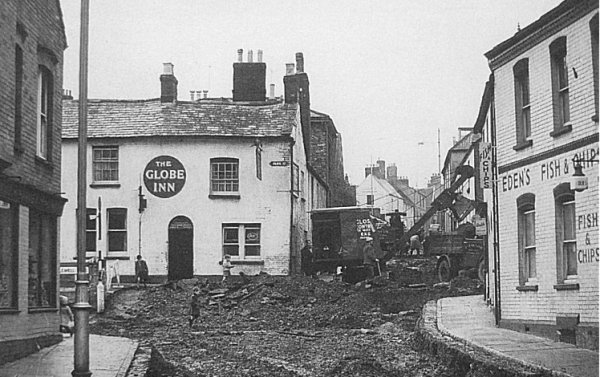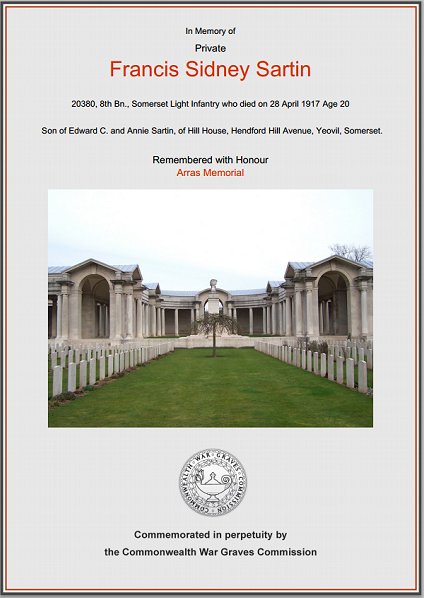yeovil at War
Francis Sidney Sartin
Killed in action during the Battle of Arleux
Francis Sidney Sartin was born in Yeovil on 8 September 1896, the son of innkeeper Edward Colthrip Sartin (1861-1932) of the Globe Inn, Park Street and Annie née Ricketts (1863-1935). In the 1891 census Edward, now aged 29, was listed as the inn keeper of the Globe Inn where he was living with Annie and their children; Nellie M (b 1887), Lillie and Bessie. In all Edward and Annie had eight children, two of whom died, and the 1901 census records Edward L (b 1893), Harry E (b 1895), 4-year old Francis and Augustus B (b 1898). A new daughter, Kathleen (b 1903) appears in the 1911 census in which 13-year old Francis listed his occupation as a 'Boy in a Glove Factory'. Edward was licensee of the Globe Inn until at least 1919, a tenancy of at least 28 years. Edward died in June 1932 and Annie died in December 1935.
Francis enlisted at Yeovil in early 1916, joining the 8th (Service) Battalion of the Somerset Light Infantry (Service No 20380). He was sent to France in the late spring of 1916. During the latter part of 1916 Francis served with his Battalion in the trenches of the Somme battlefield and was wounded on 1 July 1916. He was sent back to England where he recovered from his wound and, on 4 November 1916 returned to France.
|
A
letter
published
in the
Western
Gazette,
14 July
1916
from
"Letters
home to
Yeovil
in the
Great
War,
1914 –
1919"
by Jack
Sweet |
As part of the Arras Offensive the 8th Battalion took an active part in the First Battle of the Scarpe (9 to 14 April 1917), including the capture of Monchy-le-Preux, the Second Battle of the Scarpe (23 to 24 April 1917) and the Battle of Arleux (28 to 29 April 1917).
The Arras Offensive was a major British offensive during the First World War. From 9 April to 16 May 1917, troops from the four corners of the British Empire attacked trenches held by the army of Imperial Germany to the east of the French city of Arras.
Zero-Hour for the First Battle of the Scarpe had originally been planned for the morning of 8 April (Easter Sunday) but it was postponed 24 hours at the request of the French, despite reasonably good weather in the assault sector. Zero-Day was rescheduled for 9 April with Zero-Hour at 05:30. The assault was preceded by a hurricane bombardment lasting five minutes, following a relatively quiet night. When the time came, it was snowing heavily; Allied troops advancing across no man's land were hindered by large drifts. It was still dark and visibility on the battlefield was very poor. A westerly wind was at the Allied soldiers' backs blowing "a squall of sleet and snow into the faces of the Germans". The combination of the unusual bombardment and poor visibility meant many German troops were caught unawares and taken prisoner, still half-dressed, clambering out of the deep dug-outs of the first two lines of trenches. Others were captured without their boots, trying to escape but stuck in the knee-deep mud of the communication trenches. Most of the British objectives had been achieved by the evening of 10 April though the Germans were still in control of large sections of the trenches between Wancourt and Feuchy.
On 23 April, the British launched an assault east from Wancourt towards Vis-en-Artois. The British made initial gains but could advance no further east and suffered heavy losses. Farther north, German forces counter-attacked in an attempt to recapture Monchy-le-Preux, but British commanders determined not to push forward in the face of stiff German resistance, and the attack was called off the following day on 24 April.
In the Battle of Arleux (28 to 29 April 1917), although the Canadian Corps had taken Vimy Ridge, difficulties in securing the south-eastern flank had left the position vulnerable. To rectify this, British and Canadian troops launched an attack towards Arleux-en-Gohelle on 28 April. Arleux was captured by Canadian troops with relative ease, but the British troops advancing on Gavrelle met stiffer resistance from the Germans. The village was secured by early evening but, despite achieving the limited objective of securing the Canadian position on Vimy Ridge, casualties were high, and the ultimate result was disappointing. According to the Regimental History of the Somerset Light Infantry "The Battle of Arleux, fought on 28th and 29th of April, the 8th Somersets of the 37th Division again taking part in the operations, though the only Battalion of the regiment to do so. The front of attack was about 8 miles.... The attack of the XVII Corps was to be carried out by the 34th Division on the right and the 37th Division on the left.... Zero hour was 4:25am on 28 April. During the night of 27th/28th the eighth Battalion.... Moved forward from Heron Trench and assembled in Cuba Trench; the Battalion was in position by 3am on 28th, two platoons in front and two in rear, as each attacking battalion had been ordered to advance on a two-platoon frontage. It was so dark when Zero hour arrived that it was impossible to see more than 20 yards ahead, British and Germans being indistinguishable. Compass bearings had been taken and given to officers and NCOs, but even so, when the attack went forward, there was loss of direction. A few minutes after Zero a very heavy hostile barrage fell on the line of the road and the smoke, combined with the darkness, caused considerable confusion, with the result that the Somersets swung off to the left and Cuthbert Trench (directly east of Cuba Trench) was only partially attacked, the full weight of the attack passing on to Whip Trench, which lay some 500 yards east of Cuthbert."
It was during this early morning attack on 28 April 1917 that Richard was killed in action. He was 39 years old. Two other Yeovil men, Jack Bindon and Richard Brown were killed in the same attack and died on the same day. Francis was just 20 years old.
On 18 May 1917 the Western Gazette reported "Mr E Sartin, of the Globe Inn, South Street, received the sad intelligence on Monday morning, that his third son, Private Francis Sidney Sartin, of the Somt. Light Infantry was killed in action in France on April 28th. Private Sartin joined the Army at the beginning of 1916, and was sent to France about four months later. He was wounded in the Somme battle of July 1st 1916, and was sent to England. He recovered and returned to France on November 4th. Much sympathy is extended to the parents in their bereavement. Mr Sartin has three other sons serving in His Majesty’s Forces - two in France and the third is training in London in the Life Guards."
Francis Sartin is commemorated on Bay 4, Arras Memorial, Pas-de-Calais, France, and his name is recorded on the War Memorial in the Borough.
gallery

The Globe Inn on the corner of Park Street and South Street where Francis grew up. The photograph above was taken around 1955 while road works were being carried out to the main A30 London to the West Country road (yes, really!).

The Commonwealth War Graves Commission certificate in memory of Francis Sartin.